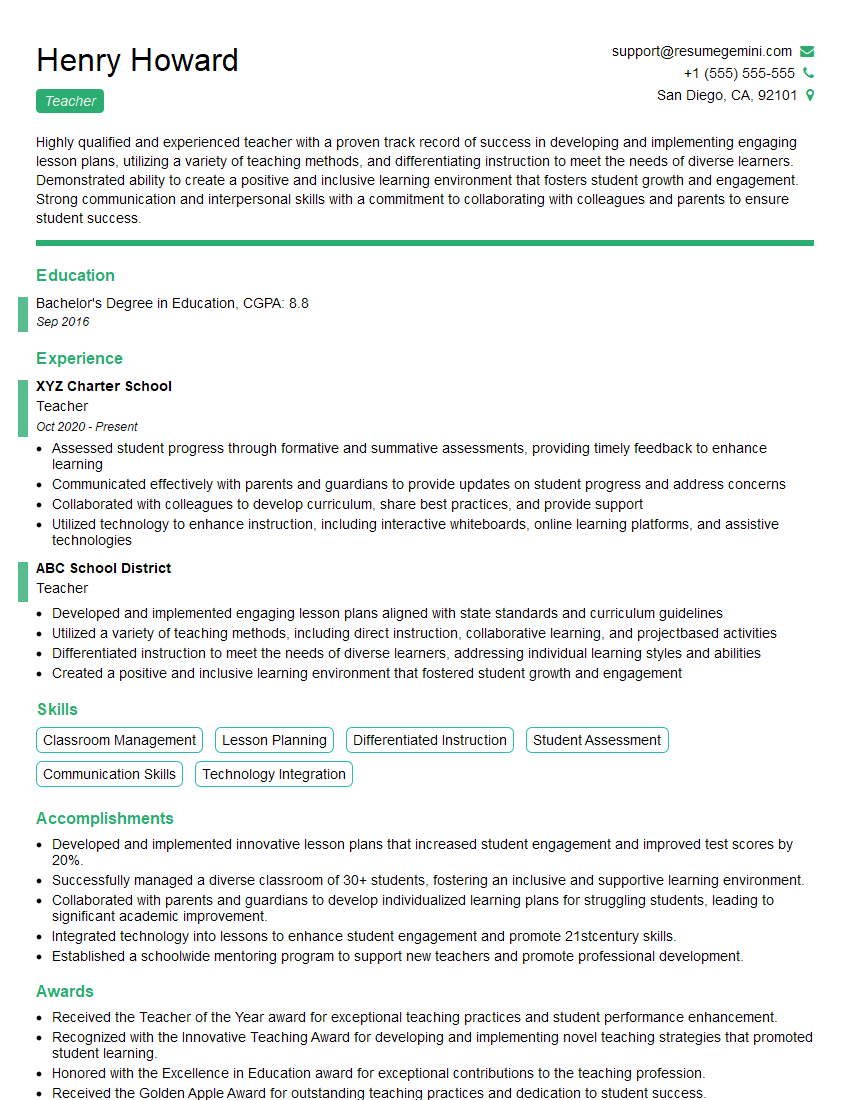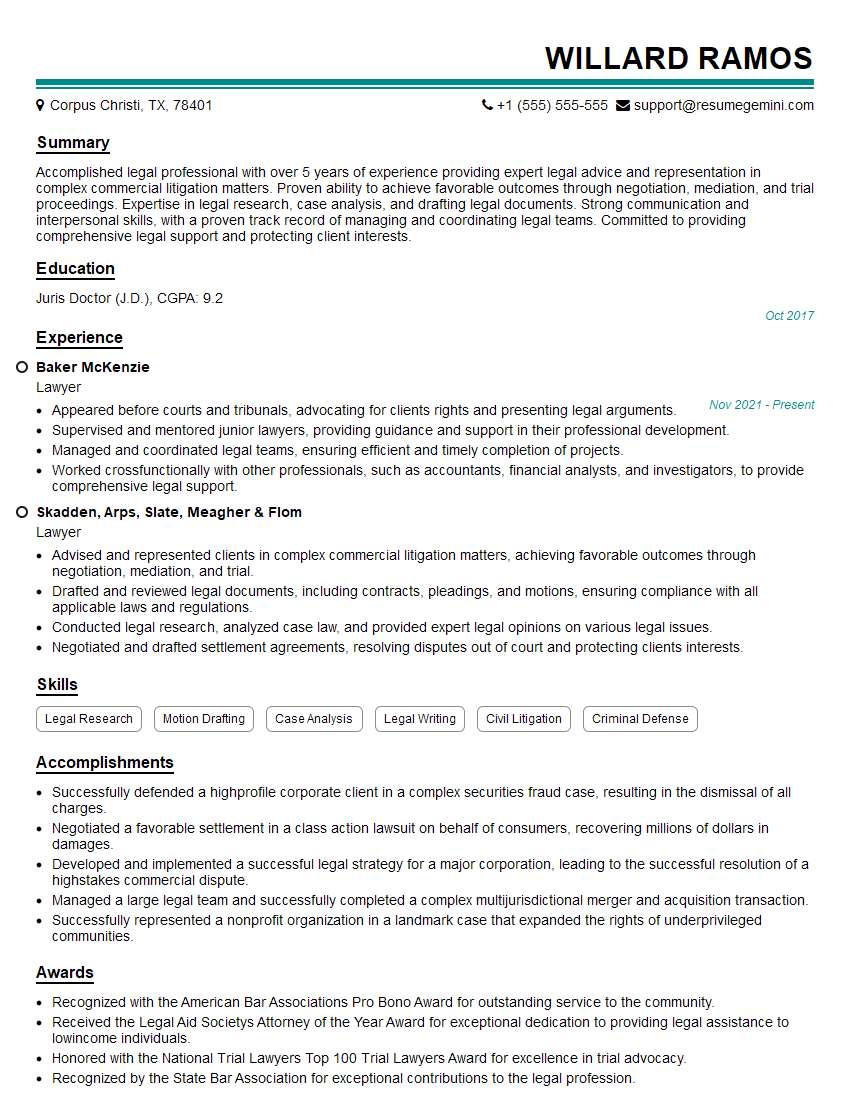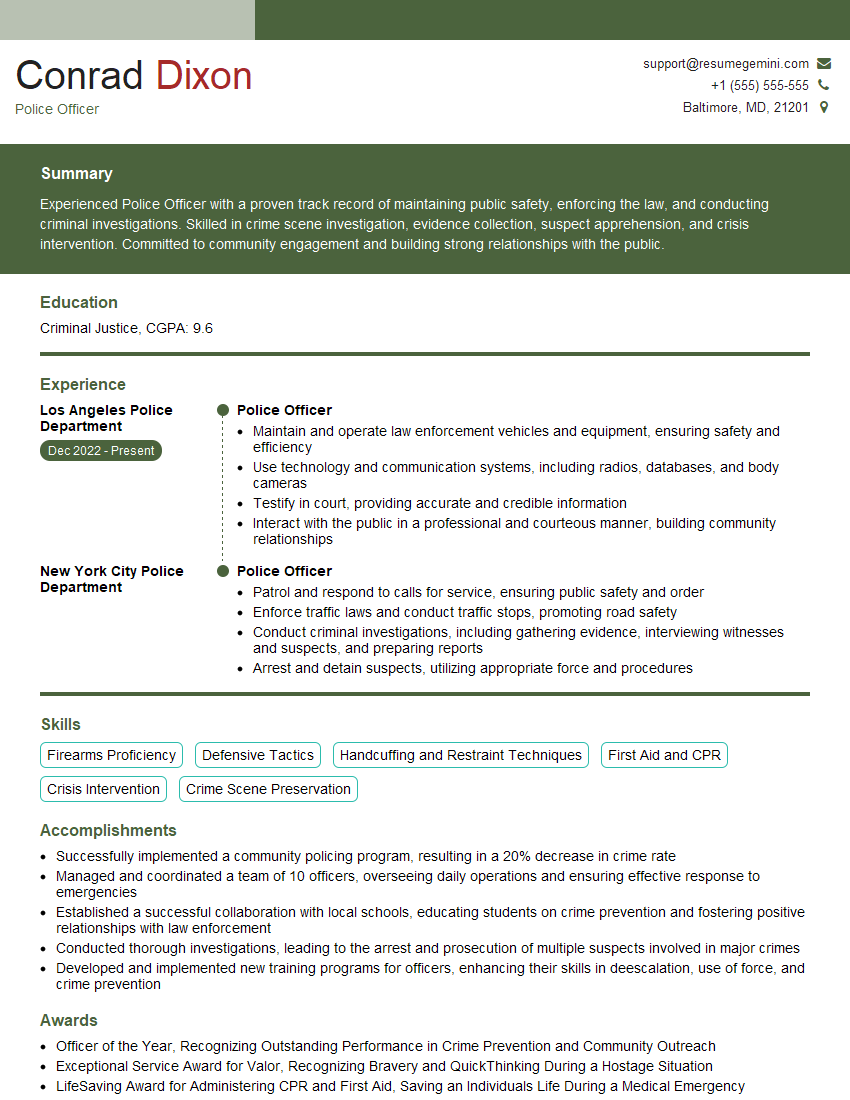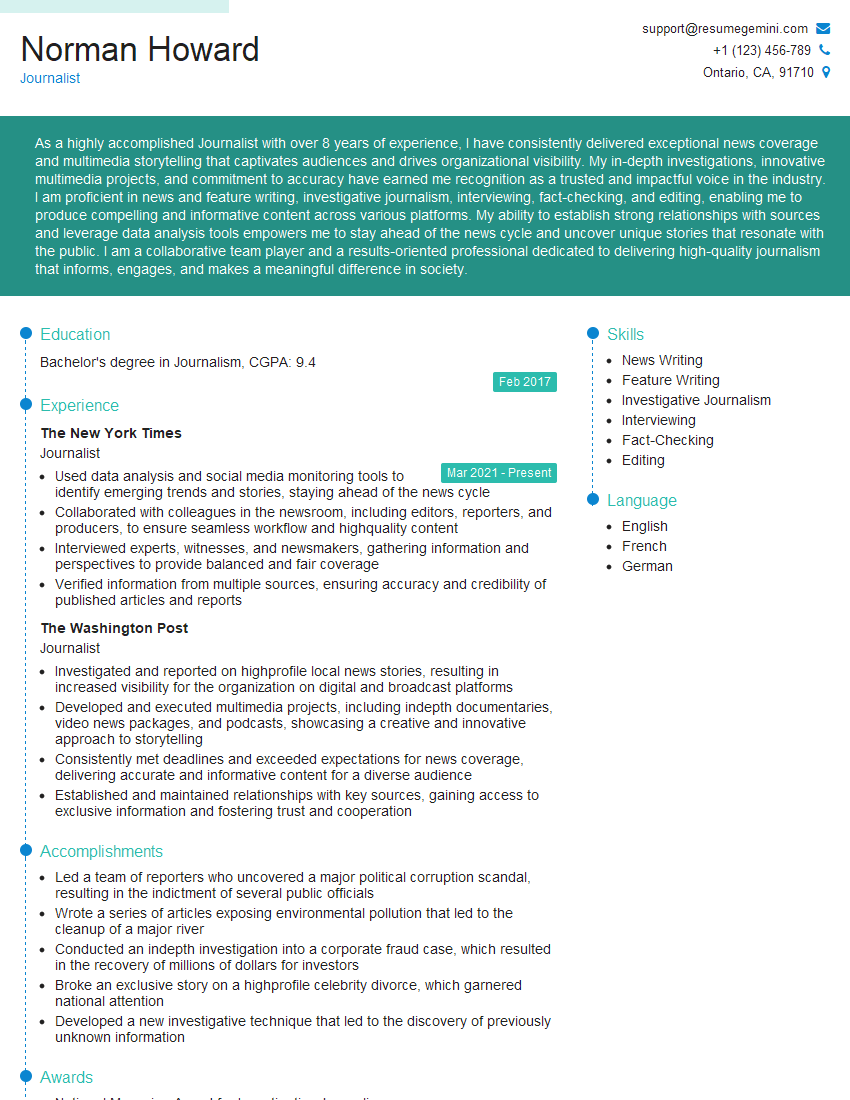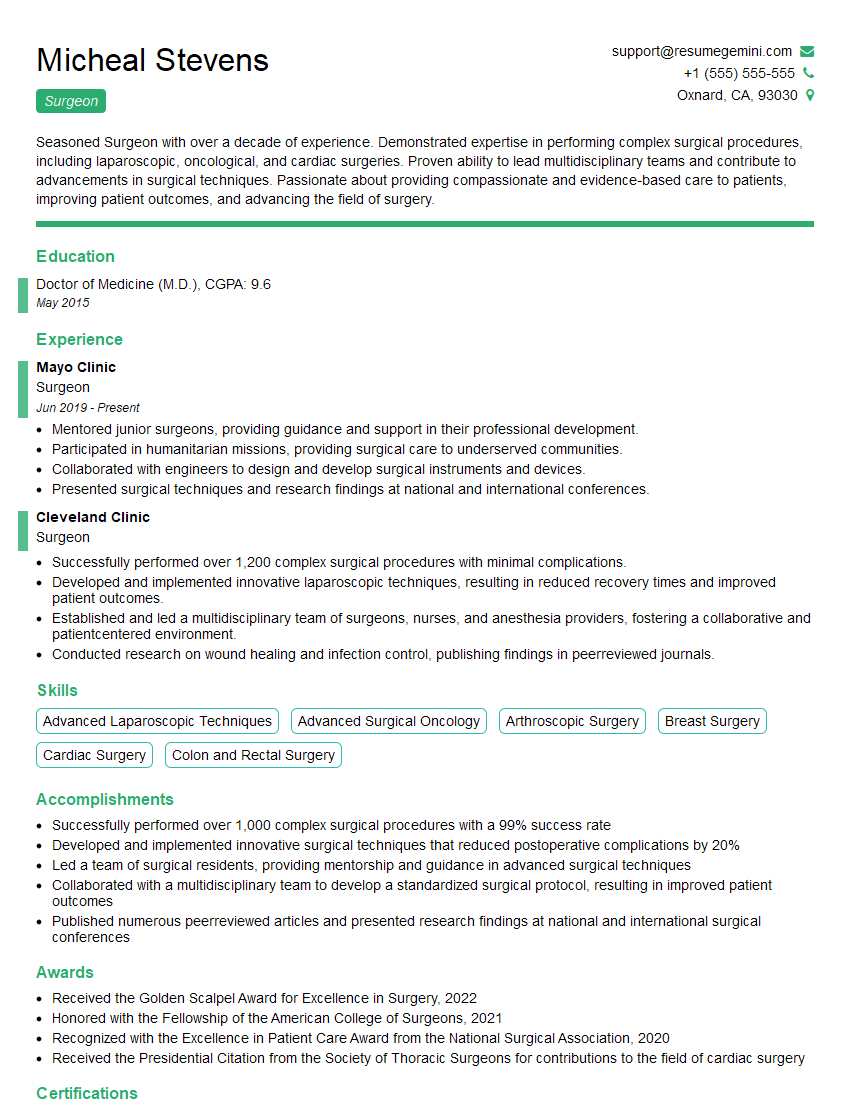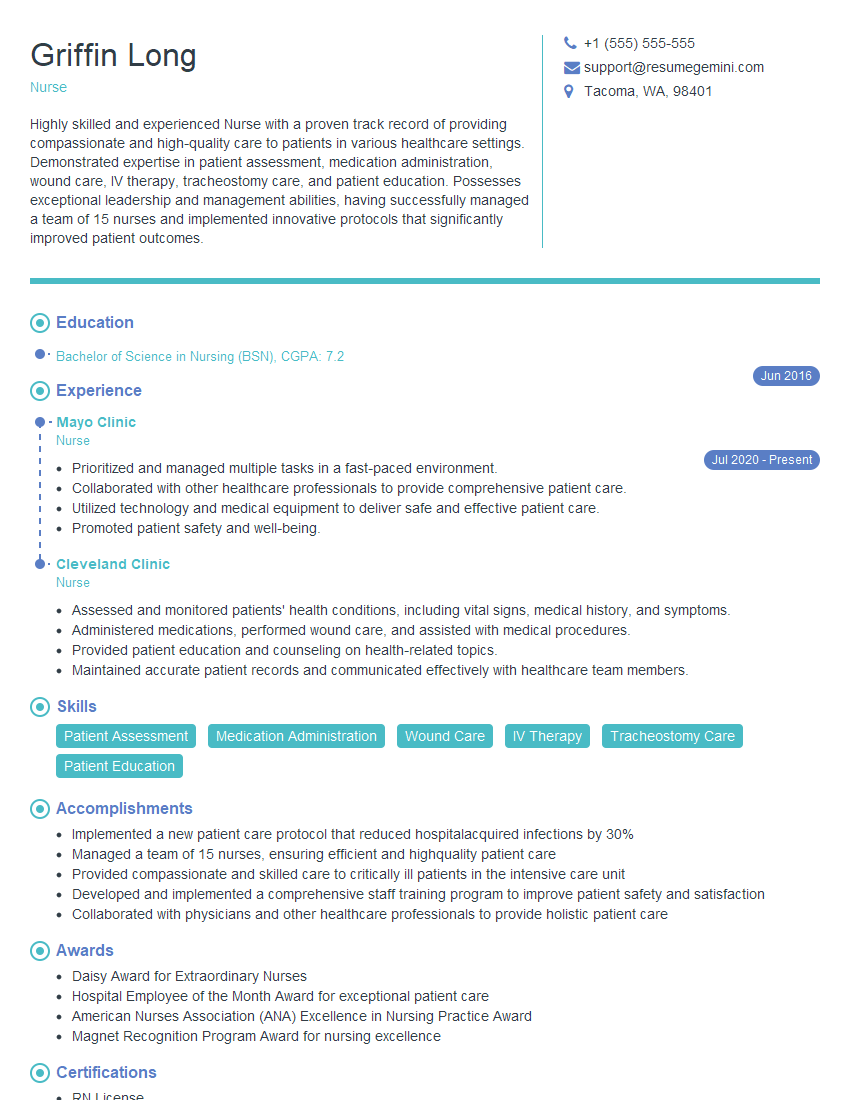Every successful interview starts with knowing what to expect. In this blog, we’ll take you through the top Ability to work effectively under pressure and meet tight deadlines interview questions, breaking them down with expert tips to help you deliver impactful answers. Step into your next interview fully prepared and ready to succeed.
Questions Asked in Ability to work effectively under pressure and meet tight deadlines Interview
Q 1. Describe a situation where you had to meet a tight deadline under pressure. What strategies did you use?
During my time at Acme Corp, we were tasked with launching a new software product within an incredibly tight three-month deadline. This involved coordinating a large team across multiple departments, each with their own dependencies and potential bottlenecks. The pressure was immense, but we successfully launched on time. My strategies included:
- Prioritization & Task Breakdown: We used a Kanban board to visualize tasks and dependencies, breaking down large projects into smaller, manageable chunks. This allowed for easier tracking of progress and identification of potential delays.
- Regular Communication & Status Meetings: Daily stand-up meetings kept everyone informed of progress and roadblocks. This fostered transparency and allowed for quick issue resolution.
- Proactive Risk Management: We identified potential risks early on (e.g., late delivery of third-party components) and developed contingency plans. This minimized the impact of unforeseen challenges.
- Resource Allocation: We strategically allocated resources to the most critical tasks, ensuring that the most skilled individuals were focused on the areas requiring the most attention.
- Effective Delegation: I delegated tasks based on individual team members’ strengths and ensured clear communication regarding expectations and deadlines.
This combination of proactive planning, efficient communication, and flexible resource allocation allowed us to navigate the intense pressure and achieve our ambitious deadline.
Q 2. How do you prioritize tasks when faced with multiple competing deadlines?
Prioritizing tasks under multiple competing deadlines requires a structured approach. I typically utilize a combination of methods:
- Eisenhower Matrix (Urgent/Important): This helps categorize tasks based on urgency and importance, allowing me to focus on the most critical items first. Urgent and important tasks take precedence, followed by important but not urgent tasks, then urgent but not important, and finally, neither urgent nor important tasks are delegated or deferred.
- Dependency Mapping: I identify dependencies between tasks, sequencing them to prevent bottlenecks. For example, if task A must be completed before task B, task A is prioritized.
- Deadline Prioritization: Tasks with the closest deadlines are prioritized, but this is always balanced with the Eisenhower Matrix. A seemingly less urgent task with a very close deadline might need to take precedence.
- Timeboxing: I allocate specific time blocks to work on particular tasks, ensuring that I’m consistently making progress on all fronts.
This multifaceted approach ensures I’m not only meeting deadlines, but also focusing on the most impactful tasks, optimizing my productivity.
Q 3. What’s your approach to managing stress and maintaining productivity under pressure?
Managing stress and maintaining productivity under pressure is crucial. My approach is multi-pronged:
- Time Management Techniques: Employing techniques like Pomodoro, timeboxing, and the Eisenhower Matrix allows me to stay focused and avoid feeling overwhelmed.
- Mindfulness & Breaks: Regular short breaks, even just five minutes, help me clear my head and refocus. Mindfulness exercises, such as deep breathing, can also significantly reduce stress.
- Physical Exercise & Healthy Lifestyle: Regular exercise and a healthy diet contribute to overall well-being and resilience under pressure. Adequate sleep is also a non-negotiable.
- Open Communication: I don’t hesitate to communicate my workload or stress levels to my manager or team, seeking support when needed. Sometimes, just verbalizing the pressure can significantly ease the burden.
By prioritizing self-care and implementing effective stress-management techniques, I ensure that I’m not only productive but also capable of sustaining my performance over the long term.
Q 4. Have you ever experienced a project failure due to time constraints? What did you learn?
Yes, I once faced a project failure due to underestimated time constraints. We were developing a new mobile application, and we underestimated the complexity of integrating with a third-party API. This resulted in significant delays and ultimately, a missed launch date. The biggest learning from this experience was the importance of:
- Accurate Estimation: We need to be more realistic in our time estimations, factoring in potential unforeseen complications and setbacks.
- Contingency Planning: Having robust contingency plans in place to mitigate risk is essential. This includes having a plan B in case of unexpected delays or failures.
- Open Communication with Stakeholders: Early and transparent communication with stakeholders about potential delays is crucial in managing expectations and preventing surprises.
This failure highlighted the importance of thorough planning, risk assessment, and proactive communication in project management. It instilled in me a deeper understanding of the need for realistic scheduling and adaptable strategies.
Q 5. Describe your experience using project management tools to track progress and meet deadlines.
I have extensive experience using various project management tools, including Jira, Asana, and Trello. My approach involves leveraging these tools for:
- Task Management: Creating detailed task lists with assigned owners, deadlines, and statuses. This ensures that all team members are aware of their responsibilities and deadlines.
- Progress Tracking: Monitoring progress against the schedule using dashboards and reports provided by the tool. This helps identify potential delays early on.
- Communication & Collaboration: Utilizing the tools’ communication features to facilitate discussions, share updates, and collaborate on tasks. This ensures transparency and efficient information flow.
- Risk Management: Identifying potential risks and tracking their mitigation efforts using features within the tool, such as risk registers or Kanban board tracking.
These tools provide essential visibility into project progress and facilitate efficient collaboration, allowing for proactive management of deadlines and resources.
Q 6. How do you handle unexpected challenges or setbacks that impact deadlines?
Unexpected challenges are inevitable. My approach involves:
- Immediate Assessment: First, I assess the impact of the challenge on the overall project timeline and deliverables.
- Communication: I immediately communicate the challenge and its potential impact to relevant stakeholders. Transparency is key in mitigating negative consequences.
- Problem-Solving: I work with the team to brainstorm solutions and develop a revised plan to address the setback. This might involve adjusting priorities, reallocating resources, or seeking additional support.
- Documentation: I document the challenge, the solution implemented, and any lessons learned. This allows for improvement in future projects.
By adapting quickly, communicating effectively, and maintaining a problem-solving mindset, I can effectively navigate unexpected challenges and minimize their impact on project timelines.
Q 7. How do you delegate tasks effectively to ensure deadlines are met?
Effective delegation is critical for meeting deadlines, especially on larger projects. My approach involves:
- Task Analysis: I carefully analyze each task, identifying the required skills and expertise.
- Matching Skills: I assign tasks to team members based on their skills and experience, ensuring that the right person is doing the right job.
- Clear Communication: I provide clear instructions, expectations, and deadlines to each team member. This includes defining success criteria and clarifying any potential ambiguities.
- Monitoring & Support: I regularly monitor progress, providing support and guidance as needed. This ensures that tasks are completed on time and to the required standard.
- Empowerment: I empower team members to take ownership of their tasks, fostering a sense of responsibility and accountability.
By delegating effectively, I leverage the strengths of my team, distribute the workload, and improve overall efficiency, ensuring that deadlines are consistently met.
Q 8. How do you communicate effectively with your team about deadlines and progress?
Effective communication is the cornerstone of meeting deadlines. I believe in proactive and transparent communication. I use a multi-pronged approach. First, I hold regular team meetings, typically short daily stand-ups, to discuss progress, roadblocks, and upcoming tasks. This fosters a sense of shared responsibility and allows for early identification of potential issues. Second, I leverage project management tools like Jira or Asana to track progress visually and provide updates to the team and stakeholders. This ensures everyone is on the same page regarding deadlines and individual contributions. Third, I utilize direct, individual check-ins to provide personalized feedback and address specific concerns. This allows me to offer tailored support and ensure everyone feels heard and understood.
For instance, during a recent project, I used daily stand-ups to track our progress on a complex feature launch. When we encountered a bug, I used the project management software to highlight the issue, assign it to the appropriate team member, and update stakeholders on the expected delay. This transparency prevented misunderstandings and kept everyone informed.
Q 9. What techniques do you use to stay organized and manage your time effectively?
Staying organized and managing time effectively under pressure is crucial. My approach combines strategic planning with flexible execution. I start by breaking down large tasks into smaller, manageable steps using techniques like the Work Breakdown Structure (WBS). This provides a clear roadmap and helps prioritize tasks effectively. I then utilize time management techniques like the Pomodoro Technique – working in focused bursts with short breaks – to maintain concentration and prevent burnout. I also rely heavily on digital tools like calendar apps, to-do lists, and note-taking applications to track deadlines, appointments and important details. Prioritization is key, I use methods like Eisenhower Matrix (urgent/important) to focus on high-impact tasks first.
For example, when faced with multiple urgent projects, I use the Eisenhower Matrix to prioritize them. Urgent and important tasks get immediate attention, while less urgent but important ones are scheduled for later. This prevents me from getting overwhelmed and ensures that the most critical tasks are completed on time.
Q 10. Describe a time you had to make a difficult decision under pressure. What was the outcome?
In a previous project, we were nearing a critical deadline, and a key feature was malfunctioning. The pressure was immense. We had two options: release with the bug, potentially impacting user experience and brand reputation, or delay the launch, risking missing a crucial market window. I gathered my team, we analyzed the risks and benefits of each approach, considering factors like the severity of the bug, the potential impact on users, and the consequences of the delay. After careful deliberation, we decided to delay the launch, prioritizing quality over a tight deadline. We fixed the bug, conducted thorough testing, and subsequently launched a successful and stable product. The outcome was positive, as it reinforced our commitment to quality and strengthened user trust.
This experience taught me the importance of making data-driven decisions under pressure, even when it means making unpopular choices.
Q 11. How do you handle conflicting priorities when working under pressure?
Conflicting priorities under pressure are a common challenge. My strategy involves a combination of clear communication, prioritization, and delegation. First, I openly discuss conflicting priorities with relevant stakeholders to ensure everyone understands the constraints and trade-offs. This helps establish shared expectations and prevents misunderstandings. Then, I utilize prioritization techniques like MoSCoW method (Must have, Should have, Could have, Won’t have) to categorize tasks based on their importance and feasibility within the deadline. Finally, when feasible, I delegate tasks to team members who possess the necessary skills and capacity. This ensures efficient use of resources and prevents any single person from being overloaded.
For instance, in a past project, I had two high-priority tasks with overlapping deadlines. Using the MoSCoW method, I identified one as a ‘must have’ and the other as a ‘should have.’ I focused my efforts on the ‘must have’ task, delegating parts of the ‘should have’ task to a capable team member. This ensured that both tasks were addressed, albeit with a slightly adjusted timeline for the ‘should have’ one.
Q 12. How do you identify potential risks or roadblocks that could impact project deadlines?
Identifying potential risks and roadblocks is crucial for effective deadline management. I employ a proactive risk assessment strategy that incorporates both planning and ongoing monitoring. During the project planning phase, I conduct a thorough risk assessment, identifying potential problems like resource constraints, technical challenges, or external dependencies. I then create a risk mitigation plan, outlining strategies to address each identified risk. Throughout the project’s execution, I continually monitor for new risks and adjust the mitigation plan as needed. Regular team meetings and progress reviews facilitate the early detection of potential delays.
For example, in one project, I anticipated a potential delay due to third-party API integration. I included this risk in my assessment, and we proactively contacted the API provider, establishing clear communication channels and alternative solutions if the initial integration failed. This proactive approach helped us avoid significant delays.
Q 13. What are your strategies for preventing burnout when working under tight deadlines?
Preventing burnout while working under tight deadlines requires a mindful approach to self-care and work-life balance. I prioritize setting realistic goals and avoiding overcommitment. I schedule regular breaks throughout the day to rest and recharge, practicing techniques like mindfulness or short exercise sessions. I also maintain a healthy lifestyle by ensuring adequate sleep, nutrition, and physical activity. Finally, I actively communicate my workload and any signs of stress to my manager and team, seeking support when needed. Open communication about workload prevents burnout and fosters a supportive work environment.
For example, I make sure to take a proper lunch break every day, even if it means working a little later. This helps me maintain my energy and focus throughout the day.
Q 14. How do you adapt to changing priorities and deadlines?
Adaptability is key to navigating changing priorities and deadlines. My approach centers around flexible planning and effective communication. I use agile methodologies, allowing for iterative development and frequent adjustments based on new information or changing requirements. I prioritize clear communication with stakeholders to understand the reasons for the changes and ensure everyone is aligned with the new priorities. I then reassess the project timeline, re-prioritize tasks, and adjust the team’s workload accordingly. Open communication prevents misunderstandings and ensures everyone remains productive and focused on the revised objectives.
For instance, in one project, a client requested a major change midway through. Instead of resisting, I promptly communicated with the team, explained the changes, and collaboratively re-evaluated the project timeline. We adopted an agile approach, prioritizing the new requirements while still delivering the core functionalities within a revised deadline.
Q 15. Can you give an example of a time you successfully navigated a crisis situation that threatened a deadline?
Navigating crisis situations that threaten deadlines requires a calm, decisive approach. It’s about prioritizing tasks, leveraging resources effectively, and communicating transparently.
In my previous role at [Company Name], we were developing a crucial software update with an extremely tight deadline. Three days before launch, a critical bug emerged in the core functionality. Panic wasn’t an option. I immediately convened a team meeting, outlining the problem and the remaining time. We prioritized fixing the bug above all else, dividing the task amongst our most skilled developers. We implemented a rapid prototyping and testing cycle, ensuring each fix was thoroughly checked before integrating it. We also communicated the situation proactively to stakeholders, managing their expectations and securing their support. We successfully launched the update, just one day behind schedule, with the critical bug resolved, demonstrating the power of quick thinking and effective teamwork under pressure.
Career Expert Tips:
- Ace those interviews! Prepare effectively by reviewing the Top 50 Most Common Interview Questions on ResumeGemini.
- Navigate your job search with confidence! Explore a wide range of Career Tips on ResumeGemini. Learn about common challenges and recommendations to overcome them.
- Craft the perfect resume! Master the Art of Resume Writing with ResumeGemini’s guide. Showcase your unique qualifications and achievements effectively.
- Don’t miss out on holiday savings! Build your dream resume with ResumeGemini’s ATS optimized templates.
Q 16. How do you measure your own success in meeting deadlines?
Measuring success in meeting deadlines isn’t solely about hitting the target date; it’s about delivering quality work *on time*. I measure success using a multi-faceted approach:
- On-time delivery: Did I meet the agreed-upon deadline?
- Quality of work: Did the final product meet the required specifications and quality standards?
- Efficiency: Did I manage my time and resources effectively? Could the work have been completed sooner without compromising quality?
- Proactive Communication: Did I consistently communicate progress and any potential challenges to stakeholders?
A successful deadline isn’t just about a ticking clock; it’s about a balance of speed and quality.
Q 17. Describe your preferred method for tracking progress towards a deadline.
My preferred method for tracking progress involves a combination of tools and techniques. I find that a visual approach is most effective.
- Project Management Software: Tools like Asana, Trello, or Jira allow for task breakdown, progress tracking, and collaborative updates. I break down large projects into smaller, manageable tasks with clear deadlines for each. This granular approach provides a clear overview of the overall project’s progress.
- Gantt Charts: These visual representations of project timelines help to identify potential bottlenecks and dependencies between tasks. This is especially useful for complex projects with multiple contributors.
- Regular Check-ins: I schedule regular check-ins with myself and my team, using these as opportunities to review progress, address any roadblocks, and readjust timelines as needed.
The key is to choose the right tool and methodology based on the project’s complexity and available resources. Consistency in updating the chosen system is crucial for accurate tracking.
Q 18. How do you ensure accuracy and quality of work when working under time pressure?
Maintaining accuracy and quality under pressure demands a structured approach. Rushing leads to mistakes.
- Prioritization: I prioritize tasks based on importance and urgency, ensuring critical aspects receive adequate attention, even under time constraints.
- Process Automation: Where possible, I automate repetitive tasks to minimize the chance of human error and free up time for more complex aspects of the project.
- Quality Checks: I build in quality checks at different stages of the process. This could include peer reviews, self-reviews, or automated testing, ensuring issues are identified and addressed early.
- Timeboxing: Allocating specific time blocks for focused work on particular tasks helps prevent multitasking and enhances concentration, improving accuracy.
It’s crucial to remember that delivering something quickly and poorly is worse than delivering something slightly late but accurately and well.
Q 19. How do you build resilience to withstand periods of intense pressure?
Building resilience to pressure isn’t about magically eliminating stress; it’s about developing healthy coping mechanisms.
- Self-Care: Prioritizing sleep, healthy eating, and regular exercise are fundamental. A well-rested and healthy mind is far better equipped to handle pressure.
- Mindfulness and Stress Management Techniques: Practices like meditation or deep breathing can significantly reduce anxiety and improve focus.
- Effective Time Management: Proactive planning and efficient time management techniques minimize last-minute rushes and reduce stress.
- Positive Self-Talk: Maintaining a positive attitude and focusing on solutions rather than dwelling on problems is crucial for resilience.
Resilience is a skill built over time through conscious effort and self-awareness.
Q 20. Describe a time you had to work overtime to meet a deadline. What was your approach?
Working overtime is sometimes unavoidable, especially on projects with challenging deadlines. My approach focuses on maintaining efficiency and avoiding burnout.
During the launch of a new marketing campaign, we faced unexpected technical issues. To meet the deadline, I worked several extra hours. My approach involved clear communication with the team about the need for extended hours, ensuring everyone felt valued and supported. I also made sure that we took short breaks to avoid exhaustion, focusing on the most critical tasks first. We completed the campaign successfully. However, it highlighted the need for better contingency planning in future projects to minimize the need for excessive overtime.
Q 21. How do you handle criticism or feedback related to missed deadlines?
Handling criticism about missed deadlines requires professionalism and a commitment to learning.
- Active Listening: I listen carefully to understand the feedback without getting defensive.
- Identifying Root Causes: I work to understand why the deadline was missed. Was it due to unforeseen circumstances, inaccurate estimations, or process inefficiencies?
- Developing Actionable Solutions: I propose specific steps to prevent similar issues in the future, demonstrating a proactive approach to improvement.
- Ownership and Accountability: I take responsibility for my actions and avoid making excuses. Honest self-reflection is key to growth.
Constructive criticism is an opportunity for improvement. By focusing on solutions and implementing changes, you can turn a negative experience into a valuable learning opportunity.
Q 22. How do you proactively identify and mitigate potential delays?
Proactive delay mitigation starts with thorough planning. It’s not about reacting to problems; it’s about anticipating them. I begin by meticulously reviewing project requirements, identifying potential bottlenecks early on. This involves brainstorming potential challenges – everything from resource availability to unexpected technical difficulties. For example, if a project relies on external data, I’d proactively contact the data provider to confirm timelines and availability, ensuring there are no surprises. If there’s a risk of delayed deliveries from a vendor, I’d explore alternative sources or build buffer time into the schedule.
Beyond identifying risks, I establish clear communication channels with all stakeholders. Regular status updates and transparent reporting allow early detection of issues, which allows us to implement corrective actions before they escalate into major delays. Using project management software with robust tracking features is also key; this helps me visually monitor progress and proactively address any slippage.
Q 23. What are some common time management techniques that you utilize?
My time management hinges on a combination of techniques. Prioritization is paramount: I use methods like the Eisenhower Matrix (urgent/important) to focus on high-impact tasks first. Time blocking allows me to allocate specific time slots for particular projects, creating structure and preventing task-switching. The Pomodoro Technique, with short focused work bursts interspersed with breaks, helps maintain concentration. Finally, I regularly review my schedule and adjust it as needed – flexibility is essential in dynamic environments. For instance, I might dedicate Mondays to planning and reviewing the week’s tasks, ensuring I’m prepared for any challenges.
Q 24. Describe your experience with using time-blocking or similar techniques.
Time-blocking has been instrumental in my success. I typically block out my calendar at the beginning of each week, allocating specific time slots for different projects or tasks. This structured approach minimizes context switching and maximizes my focus. For example, I might dedicate two hours on Tuesday mornings to writing a report, and then another two hours in the afternoon for client meetings. I treat these time blocks as appointments I cannot miss. I also include buffer time in my schedule, accounting for unexpected interruptions or tasks that take longer than anticipated. This prevents a single delay from cascading into the rest of the day.
While I usually plan my blocks in advance, I remain flexible. Unexpected urgent tasks sometimes require adjustments. I simply review my schedule, identify a less crucial block, and shift it. The key is to be organized enough to be able to make these adjustments efficiently without losing significant progress.
Q 25. How do you balance multiple projects with different deadlines?
Balancing multiple projects requires a strategic approach. I start by clearly defining the priorities of each project, considering factors like deadlines, impact, and stakeholder expectations. This often involves creating a prioritized task list that integrates tasks across all projects. Visual tools like Kanban boards can be invaluable for visualizing workflow and progress across multiple projects. Then, I break down larger projects into smaller, more manageable tasks, allocating these tasks across my time blocks, ensuring that critical tasks for projects with imminent deadlines get the necessary attention.
Regularly reviewing progress across all projects is crucial. I use project management software to track deadlines, milestones, and resource allocation. This allows me to proactively identify any potential conflicts or delays and adjust my schedule accordingly. For example, if one project starts to fall behind, I might temporarily shift resources from a less critical project to get it back on track.
Q 26. How do you maintain focus and avoid distractions when working under pressure?
Maintaining focus under pressure is a skill honed over time. I minimize distractions by creating a dedicated workspace free from interruptions. This includes turning off notifications on my phone and computer and communicating my need for uninterrupted time to colleagues. The Pomodoro Technique helps keep me focused during work sessions. The short breaks prevent burnout and allow me to refresh my mind before tackling the next task. Additionally, I practice mindfulness techniques, such as brief meditation, to help me center myself when feeling overwhelmed.
Sometimes, I find it helpful to work in short bursts with dedicated breaks in between. This way, even under a lot of pressure, the process seems less daunting than staring at a seemingly impossible task. Planning is also key: I make sure the environment is set up to facilitate the workflow and have resources handy. This significantly decreases the mental load when working under tight deadlines.
Q 27. How do you ensure you are getting adequate rest and self-care while meeting deadlines?
Balancing work and self-care is essential, particularly under pressure. I prioritize adequate sleep, aiming for 7-8 hours each night. I also schedule regular breaks throughout the day to move around, stretch, or simply step away from my computer. These short breaks are crucial for preventing burnout and maintaining focus. I incorporate exercise and healthy eating habits into my routine; this enhances both physical and mental well-being. Making time for hobbies and relaxation activities, even small ones like reading for 15 minutes or listening to music, is also crucial for reducing stress and maintaining a positive mental state. Essentially, preventing burnout through self-care is crucial for maintaining performance and preventing errors.
Q 28. Describe a time when you had to make a trade-off between speed and quality. How did you handle it?
In a past project, we faced a critical deadline for a software release. We encountered unexpected technical challenges that threatened to compromise the quality of the final product if we adhered strictly to the timeline. After careful assessment, we decided to make a strategic trade-off: We postponed the release by a week. This allowed us to fully address the technical issues, ensuring the final product met our quality standards, even though it meant pushing back the initial deadline.
This decision involved transparent communication with stakeholders, clearly explaining the reasons behind the delay and the benefits of delivering a high-quality product over a slightly delayed one. Fortunately, stakeholders understood and appreciated the commitment to quality. The extra week allowed us to thoroughly test the software, fixing critical bugs and significantly improving the user experience. This resulted in positive customer feedback and solidified our reputation for delivering reliable and high-quality products.
Key Topics to Learn for Ability to work effectively under pressure and meet tight deadlines Interview
- Prioritization and Time Management: Learn effective techniques for prioritizing tasks, allocating time efficiently, and managing competing deadlines. Consider frameworks like Eisenhower Matrix (urgent/important).
- Stress Management and Resilience: Explore strategies for managing stress and maintaining composure under pressure. This includes identifying personal stressors and developing coping mechanisms.
- Proactive Problem Solving: Practice anticipating potential roadblocks and developing contingency plans. Highlight experiences where you identified and solved problems proactively to meet deadlines.
- Communication and Collaboration: Demonstrate your ability to communicate effectively with team members, managers, and clients, especially during high-pressure situations. Showcase examples of collaborative problem-solving.
- Adaptability and Flexibility: Emphasize your ability to adjust to changing priorities and unexpected challenges. Provide examples where you successfully adapted to a rapidly changing situation.
- Self-Awareness and Self-Regulation: Understand your personal work style and limitations under pressure. Demonstrate how you use this self-knowledge to improve performance and manage your workload effectively.
- Technology and Tools: Discuss your proficiency with project management software (e.g., Asana, Trello) and other tools that enhance productivity and efficiency under pressure.
Next Steps
Mastering the ability to work effectively under pressure and meet tight deadlines is crucial for career advancement. It demonstrates key attributes highly valued by employers: resilience, adaptability, and strong problem-solving skills. To significantly boost your job prospects, create an ATS-friendly resume that clearly showcases these abilities. ResumeGemini is a trusted resource to help you build a professional and impactful resume. Examples of resumes tailored to highlight your ability to work effectively under pressure and meet tight deadlines are available to help guide you. Invest time in crafting a strong resume – it’s your first impression and a key to unlocking your career potential.
Explore more articles
Users Rating of Our Blogs
Share Your Experience
We value your feedback! Please rate our content and share your thoughts (optional).
What Readers Say About Our Blog
Hello,
We found issues with your domain’s email setup that may be sending your messages to spam or blocking them completely. InboxShield Mini shows you how to fix it in minutes — no tech skills required.
Scan your domain now for details: https://inboxshield-mini.com/
— Adam @ InboxShield Mini
Reply STOP to unsubscribe
Hi, are you owner of interviewgemini.com? What if I told you I could help you find extra time in your schedule, reconnect with leads you didn’t even realize you missed, and bring in more “I want to work with you” conversations, without increasing your ad spend or hiring a full-time employee?
All with a flexible, budget-friendly service that could easily pay for itself. Sounds good?
Would it be nice to jump on a quick 10-minute call so I can show you exactly how we make this work?
Best,
Hapei
Marketing Director
Hey, I know you’re the owner of interviewgemini.com. I’ll be quick.
Fundraising for your business is tough and time-consuming. We make it easier by guaranteeing two private investor meetings each month, for six months. No demos, no pitch events – just direct introductions to active investors matched to your startup.
If youR17;re raising, this could help you build real momentum. Want me to send more info?
Hi, I represent an SEO company that specialises in getting you AI citations and higher rankings on Google. I’d like to offer you a 100% free SEO audit for your website. Would you be interested?
Hi, I represent an SEO company that specialises in getting you AI citations and higher rankings on Google. I’d like to offer you a 100% free SEO audit for your website. Would you be interested?
good







